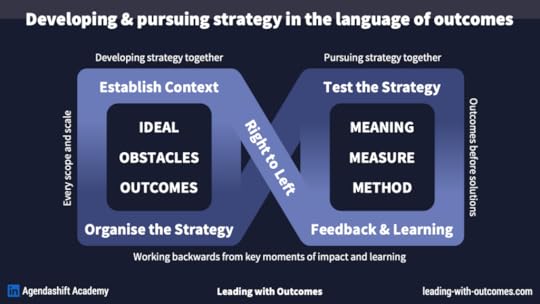Explaining the “unreasonable effectiveness” of Agile
Anyone who has worked in an environment where Agile is working well will agree: when it’s great, it’s really great. However, this post is not about what separates the great from the mediocre or worse (for that I would recommend my 2019 book Right to Left), but about Agile’s impact on the organisation more broadly.
Agile’s benefits are usually touted in terms of things like these:
Delivery speed (“twice the work in half the time”)Rate of learning, enabled by incremental and iterative delivery coupled with regular reflectionAbility to adapt (“responding to change over following a plan”)Customer satisfaction, enabled by the aboveDon’t worry, I’m not about to say that there’s anything wrong with any of these. Notice however how all but the last one are about what’s happening in the team or value stream, and as is so often the case with things Agile-related, none of them have anything at all to say about the wider organisation.
This has long bothered me, but for once I am going to be positive about that poorly understood relationship. What if Agile’s “unreasonable success” (when it happens) could be traced to organisational effects attributable to the Agile manifesto’s emphasis on “individuals and interactions”?
Starting with the team:
Improvements to communication and decision-making capacity at team level encourage self-organisation and other emergent behaviours (this relationship has been observed for decades)Then the overlooked but very significant second-order benefit:
The decision-making burden on the surrounding organisation is thereby reduced, increasing both its available decision-making capacity and the possibility of emergent outcomes at larger scalesMore succinctly: Agile increases its surrounding organisation’s decision-making capacity. What it does with that is of course down to the organisation itself, but it’s interesting that if its communication capacity is correspondingly good (or correspondingly improved), emergent outcomes are made very much more likely. Nice, and without any mention of process, not the easiest of things to scale!
A couple of parallels:
Channeling Modig & Åhlström’s This is Lean, we might describe Agile as “a strategy for improving an organisation’s decision-making capacity”Skelton & Pais’s Team Topologies talks of “reducing cognitive load”. It’s written more with team-level benefits in mind I think, but it’s an excellent starting pointTo the first of those (and perhaps the second), it wouldn’t be completely wrong to describe Lean or Lean-Agile in those terms either. But that ship has sailed, and flow remains an important concept even if waste and its elimination lack something in attractiveness if not generativity.
Happily for me, I am free (within reason) to describe the Deliberately Adaptive Organisation in whatever way I like. Already, this idea of “improving an organisation’s decision-making capacity” is one of its key concerns.
Learn more:
4-6 October, Melbourne, Australia:Leading in a Transforming Organisation 14-16 November, Manchester, UK:
Leading in a Transforming Organisation Online, self-paced:
Adaptive Organisation: Business agility at every scale Upcoming events
With me (Mike Burrows) unless otherwise indicated:
September:
05 September, online, 15:00GMT, 16:00CET, 10am ET:Free webinar/AMA: What if we put agreement on outcomes before solutions? 12-20 September, online, Tuesday & Wednesday afternoons (UK time):
Leading with Outcomes: Train-the-Trainer/Facilitator (TTT/F)
October:
4-6 October, Melbourne, Australia:Leading in a Transforming Organisation 09 October, Melbourne, Australia:
Kanban Australia 2023 17 October, online, 15:00GMT, 16:00CET, 10am ET:
Free webinar/AMA: How do we keep outcomes in the foreground?
Later:
09 November, online meetup, 11:30 GMT, 12:30 CST, 06.30am ET:Between spaces, scopes, and scales: What the scaling frameworks don’t tell you 14-16 November, Manchester, UK:
Leading in a Transforming Organisation 1-2 December, Bengaluru, India:
Kanban India 2023 3-4 December, Bengaluru, India:
Leading with Outcomes: Train-the-Trainer / Facilitator (TTT/F)
Leading with Outcomes from the Agendashift Academy
“Leadership and strategy in the transforming organisation”
Leading with Outcomes is our modular curriculum in leadership and organisation development. Each module is available as self-paced online training or as private, instructor-led training (online or in-person). Certificates of completion or participation according to format. Its four modules in the recommended order:
Leading with Outcomes: Foundation Inside-out Strategy: Fit for maximum impact Outside-in Strategy: Positioned for success Adaptive Organisation: Business agility at every scale (parts I and II, a certificate for each)Individual subscriptions from £24.50 per month, business subscriptions from £269 per month, with discounts available on both kinds of plan for employees and employers in the government, healthcare, education, and non-profit sectors.
For public training events, see our Events calendar. These are discounted for subscribers when the event is operated by us.
To deliver Leading with Outcomes yourself, see our Authorised Facilitator and Trainer Programmes. Our next TTT/F trainings take place in September (online) and December (Bengaluru, India).
Agendashift : Serving the transforming organisation
: Serving the transforming organisation
Links: Home | Subscribe | Events | Media | Contact | Mike
Agendashift Academy: Leading with Outcomes | Trainer and Facilitator Programmes
At every scope and scale, developing strategy together, pursuing strategy together, outcomes before solutions, working backwards (“right to left”) from key moments of impact and learning.




